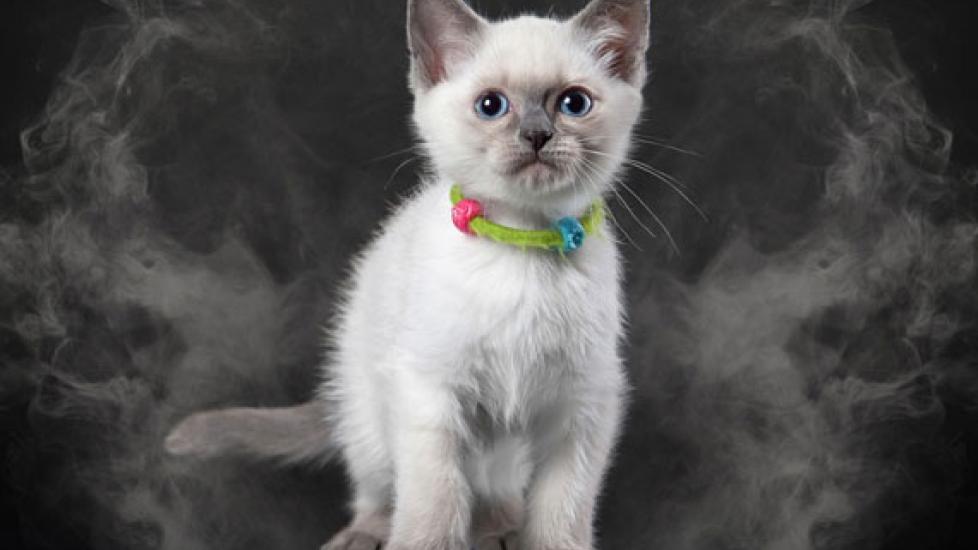Risks of Second Hand Smoke for Dogs and Cats
Do you smoke? Have you thought about the adverse effect the habit is probably having on your pets’ health?
Research shows just how dangerous second and third hand smoke is to the animals who live with us. Second hand smoke is defined as smoke that is exhaled or otherwise escapes into the air and can be inhaled by non-smokers, including pets. Third hand smoke is the residue that remains on skin, fur, clothing, furniture, etc., even after the air has cleared. Both of these categories can be combined under the term environmental tobacco smoke (ETS).
One of the most dramatic studies that I’ve run across reveals a greatly increased risk of malignant lymphoma (also referred to as lymphoma or lymphosarcoma) in cats with exposure to ETS. The results showed that the relative risk for malignant lymphoma in cats with any household ETS exposure was almost 2 ½ times higher than that of cats living in smoke-free households. For cats with five or more years of ETS exposure, the relative risk climbed to 3.2. In other words, these cats were more than three times as likely to develop lymphoma as were cats who were not exposed to ETS.
Recommended Pet Products
This study and others like it also strongly suggest a link between oral cancer in cats and environmental tobacco smoke. Cats groom the toxins contained in tobacco smoke off of their fur, which damages tissues within the mouth, leading to cancer.
Dogs aren’t immune to the effects of ETS either. Research shows that dogs living with smokers are more likely to suffer from respiratory diseases (e.g., asthma and bronchitis) and lung cancer than are dogs that live in smoke-free homes. Also, the risk of cancer of the nasal passages increases by 250% in long-nosed breeds of dogs with exposure to high levels of environmental tobacco smoke. It looks as if the numerous poisons found in cigarette smoke build up in the nasal passages of long-nosed dogs but are more able to make their way to the lungs of dogs with shorter noses.
Unfortunately, studies show that smoking outside of the home only helps but does not eliminate ETS exposure to infants. The infants of parents who smoked outdoors were still exposed to 5-7 times as much ETS as were the infants of nonsmokers. Similar results could be expected for pets.
Is vaping (inhaling a vaporized solution that contains nicotine) a safer alternative? Maybe, but according to the American Lung Association, “the FDA tested a small sample [of e-cigarettes] just a few years ago and found a number of toxic chemicals, including diethylene gylcol — the same ingredient used in antifreeze.” That’s certainly not something that I’d want pets to inhale or lick off their fur.

Dr. Jennifer Coates
References
Passive smoking and canine lung cancer risk. Reif JS, Dunn K, Ogilvie GK, Harris CK. Am J Epidemiol. 1992 Feb 1;135(3):234-9
Households contaminated by environmental tobacco smoke: sources of infant exposures. Matt GE, Quintana PJ, Hovell MF, Bernert JT, Song S, Novianti N, Juarez T, Floro J, Gehrman C, Garcia M, Larson S. Tob Control. 2004 Mar;13(1):29-37
The dog as a passive smoker: effects of exposure to environmental cigarette smoke on domestic dogs. Roza MR, Viegas CA. Nicotine Tob Res. 2007 Nov;9(11):1171-6.
Environmental tobacco smoke and risk of malignant lymphoma in pet cats. Bertone ER, Snyder LA, Moore AS. Am J Epidemiol. 2002 Aug 1;156(3):268-73.
Cancer of the nasal cavity and paranasal sinuses and exposure to environmental tobacco smoke in pet dogs. Reif JS, Bruns C, Lower KS. Am J Epidemiol. 1998 Mar 1;147(5):488-92.
Image: dien / Shutterstock

